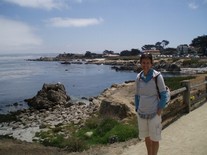EARTHWATCH KIDS
Be a Rock Hound!
Wednesday, August 6, 2008

As I search the beaches here along Monterey Bay, I am collecting some beautiful samples of shells, driftwood, and rocks to bring back to our classroom. I am also looking for a very special rock, as I always do when I travel. I think that it would be fun for all of us to bring a summer Field Rock to school in September. Maybe you'll discover that you like rocks that are black and smooth and have white lines (called veins) through them. Whenever I find a rock like that, I save it because my sister, Star, once told me that they are good luck. Maybe you'll choose a rock that is white and clear, or maybe a rock that is black and grey and sort of speckled. Ask your family to help you jot down your location when you find your rock, and what it was about the rock that caught your eye, which really means the thing about the rock that made you like it when you first saw it. Bring your rock (with your initials marked on the bottom) and your notes to school. We'll share our rocks and their stories, and mark their locations on a map of the United States. Maybe, we will even use a World Map, if some of our Field Researchers travel far, far away from home!
Recently, our Earthwatch Research Team monitored the otters in the North Harbor of Moss Landing for a full 24-hour period (that is a whole day). I arrived at my post with binoculars and a night scope at 4 a.m. (this was really fun because it was pitch-dark and I felt like a secret agent on a very important spy mission)! As I worked with my Earthwatch colleague, we counted the total number of otters every 30 minutes, and made a note of their behaviors. During this time, most of the otters were resting together in an otter raft, which looks like a large quilt made of otter squares. A few other otters were working hard to stay warm by grooming (fluffing up) their double-layered, dense, shiny hair. Several of the otters chose to leave the water altogether, and they climbed onto the beach to rest. In Field Researcher world, this is called hauling out, an otter behavior observed by scientists only in the past few years. Otter experts here think that the otters may have recently re-learned this trait from watching the outdoor otters living at the Monterey Bay Aquarium! However, hauling out of the water was also likely an original trait of otters many decades, and even centuries ago, before hungry bears and coyotes hunting along the California coastline drove the otters back into the sea.
Then as the sun began to rise around 6:00 a.m., the otters began to travel and interact with each other, and several otters paddled (and ruddered using their paddle-like tails) to the harbor entrance to begin their morning foraging for clams, innkeeper worms, and crabs.
Around 9:00 a.m. we counted the number of otters traveling through the harbor jetty to look for food further out in Monterey Bay, which is really more like open ocean than a typical bay. This jetty is the same narrow passage that sardine and anchovy fishing boats, kayaks, and schooners use when departing from, and returning to, Moss Landing Harbor. All of our combined otter counts were later fed into a computer at Earthwatch's office in Moss Landing. When this information is analyzed and studied, Dr. Daniela Maldini and her Field Director, Mark Cotter, as well as local otter experts like Robert Scoles and Ronald Eby, may be able to better inform the public about actions that could further protect the southern otter population today, and in the future.
Fun Otter Fact #7:
When there are lots of sea otters resting and/or playing together, it is called an otter raft. I have seen otter rafts every day here in Moss Landing. Sometimes I even think that one or two otters actually wave back at me when I wave at them! They are, after all, very sociable, and they love to make new friends!
Check out this website to learn more about otters!
The Otter Project www.otterproject.org
Original article can be found here: http://www.earthwatchkids.net/subBlog.asp?bID=136